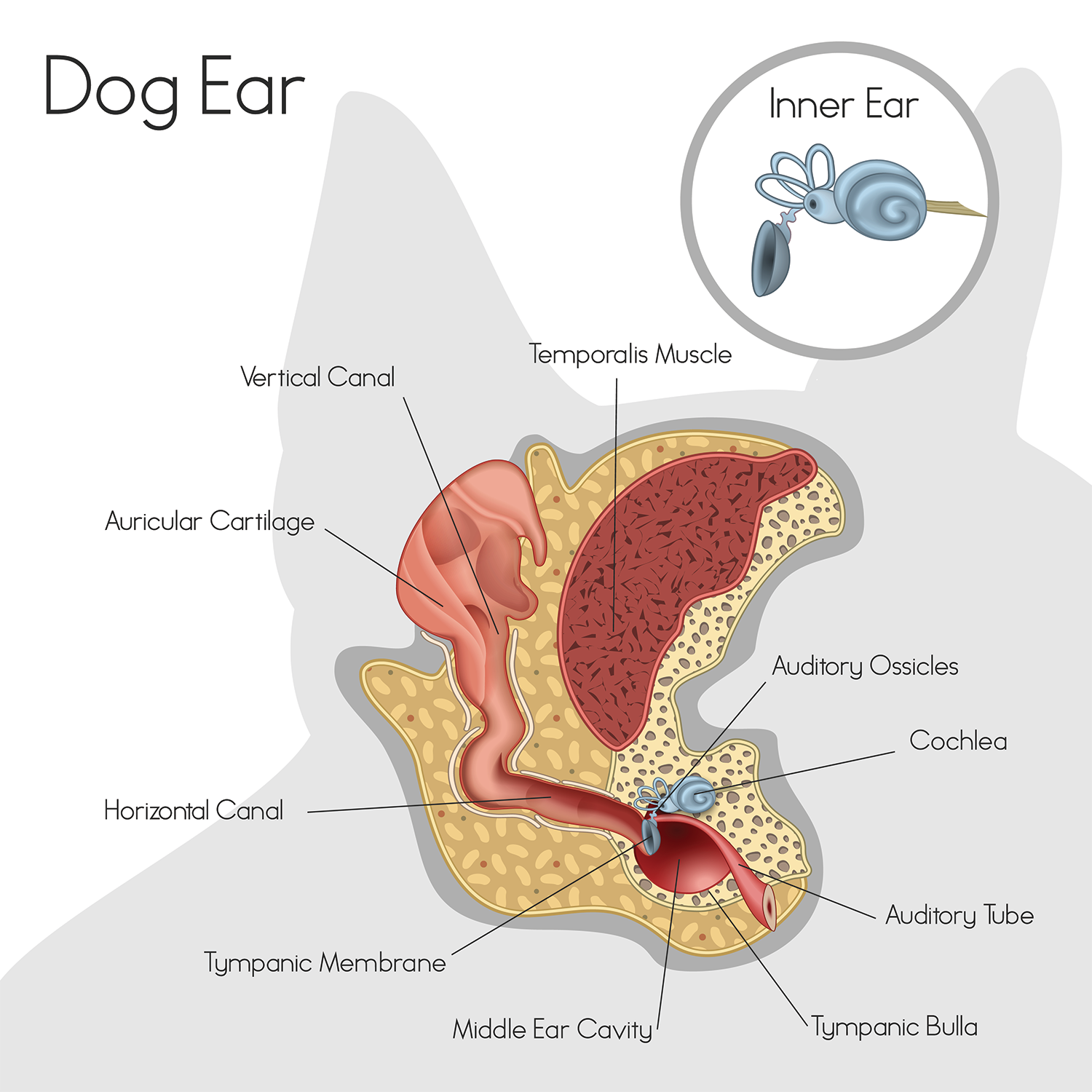Ear infections are incredibly common in dogs, with some dogs having to deal with them almost constantly
Considering how few ear infections other animals (including us) get, you have to wonder what on earth is going on with dogs.
Here we'll look at what causes ear infections in dogs and what we can do about them.
What do we mean by ear infection?
When we say ear infection, we're usually referring to an infection of the ear canal. The medical term for this is otitis externa. Otitis simply means inflammation of the ear. As the inflammation is so frequently associated with infection, otitis has come to mean ear infection rather than just ear inflammation.
There are three types of otitis depending on which part of the ear is affected:
otitis externa – involving the (external) ear canal (ie the part that opens to the outside)
otitis media – involving the middle ear
otitis interna – involving the inner ear
All three types occur in dogs but the external ear canal is overwhelmingly affected compared to the other two areas.
What causes otitis externa?
There are a two main factors that make dogs so prone to ear infections:
the shape of the ear canal
the prevalence of conditions that cause excess ear wax
Let's look at these two factors.
Why being dogeared is a problem
The dog's ear canal has both a vertical and a horizontal component (see image above). This L shape means that the normal ear wax and other debris (skin oil, dead cells, hair etc) that accumulate in the ear must work their way upward rather than straight out.
If this isn't enough of a challenge, some dogs have additional obstructions to wax exiting such as:
narrowing of the ear opening (common in certain breeds such as Shar-pei)
hair growth deep in the canal (common in Poodles, Poodle crosses and Schnauzers)
If ear wax cannot get out, it builds up. And when this happens, the moisture of the wax promotes growth of bacteria and fungi/yeasts that live in the normal ear canal, leading to an infection.
Wax and more wax
Anything that stimulates ear wax production increases the risk of ear infection. Things that do this include:
irritation from water in the ear canal after a bath or swimming
some diseases, especially allergic skin disease (which is the most common cause for recurring increased ear wax production/ear infection)
ear mites (now rare due to all-in-one parasite control products)
foreign bodies (eg grass seeds)
The role of yeasts
Yeast infection is the most common type of ear infection in dogs. The yeast organisms are fungi called Malassezia pachydermatis and they are a normal part of flora on the skin and in the ears.
When the ear becomes inflamed and the canal environment changes, the yeast overgrows and creates a brown or grey greasy ear discharge. It's pretty itchy and often quite smelly too.
The change to the ear canal environment from the yeast infection may also lead to bacterial overgrowth and therefore, a mixed infection.
Yeast overgrowth can have many underlying causes but allergy is particularly common. If the ear infection involves the ear flap or entrance to the ear canal rather than the canal itself, this is a hint that allergy is at the root of the problem. In these patients, ear infections are often recurrent and accompanied by other skin disease. Regular ear cleaning is recommended to reduce yeast numbers and control the recurrent inflammation.
What are the signs of otitis externa?
The main signs are:
scratching at the ear or ears
head shaking
dropped carriage of ear(s)
You might also notice a smell, a discharge and a red appearance of the skin of the ear canal entrance. The ear or ears may be painful to touch.
In most cases, dogs are still eating, drinking and behaving normally. But if the infection becomes severe, your dog might seem quieter than usual and go off food (chewing uses the muscles around the ears and can cause pain).
Potential complications of otitis externa
If an ear infection isn't uncomfortable enough, it can lead to additional problems.
Canal damage and middle ear involvement
A persistent ear infection can lead to chronic inflammation and scarring in the canal, which narrows it further and makes the infection especially difficult (and potentially impossible) to clear up. In severe cases, the ear canal can actually turn into bone (ie mineralise) and the middle ear may be affectedS, leading to nerve damage.
Signs of nerve involvement include a head tilt, a lack of balance and unusual back-and-forth eye movements called nystagmus. These symptoms are called vestibular signs and are a complication of middle ear infection. Middle ear infections can also cause paralysis of the facial nerve, leading to a slack-jawed appearance on that side of the face.
Aural haematoma
Vigorous head shaking and ear scratching can cause blood vessel rupture in the earflap. When this happens, the blood accumulates between the skin and the cartilage in the ear and forms a haematoma (like a deep blood blister).
We can treat these with time, drainage or surgery. The choice depends on the size and level of discomfort of the haematoma.
How to treat otitis externa
In most cases, ear infections are simple and easily cleared up. But they can be challenging, especially to 'cure' completely.
Simple ear infections
Most ear infections are treated quite simply with medication at home. We often take a sample of ear discharge and examine it under the microscope to help us choose which medication to use.
In many cases, we try to clean out the debris before we start putting medication down the ears. If there is only mild debris in the ear canals, a simple clean with a gentle ear cleaner is enough. If there is extensive debris in the canal or if the ear(s) are too sore to touch, a full ear flush under sedation may be needed.
After 1–2 weeks of home treatment, the ear canals should be rechecked to be sure the infection is gone. In most cases this completes treatment but for stubborn cases, we might need to proceed to the next step.
Persistent ear infections
Some dogs have chronic ear problems, where the infection is not controlled by general medication or returns when general medication is discontinued. If this is your dog, we will probably recommend that the ear discharge is sent away to an external laboratory for culture and sensitivity. This involves growing the bugs so that the precise organism can be pinpointed and seeing what antibiotics will work against them. Along with medication, regular and ongoing cleaning at home will be needed.
Further testing may be in order to determine why the infection continues to recur. Allergy is the most common reason for recurrent ear problems but hormone imbalances can also be underlying causes.
The end-stage ear
Some ear infections simply cannot be controlled with the above steps. These cases have gone beyond medical management and must proceed to surgery if we want to 'fix' the problem. What this entails will depend on the state of the ear canal. One of the most common procedures is a total ear canal ablation (TECA), where the whole external ear canal is removed, leaving behind an ear flap but no opening underneath.
Let us know if you would like any additional information.








